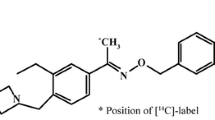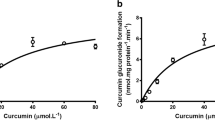Abstract
Purpose. To evaluate an interaction between simvastatin and itraconazole in in vitro studies and to attempt a quantitative prediction of in vivo interaction in humans.
Methods. The inhibitory effect of itraconazole on simvastatin metabolism was evaluated using human liver microsomes and the Ki values were calculated for the unbound drug in the reaction mixture. A physiologically-based pharmacokinetic model was used to predict the maximum in vivo drug-drug interaction.
Results. Itraconazole competitively inhibited the metabolism of simvastatin to M-1 and M-2 with Ki values in the nM range. The area under the curve (AUC) of simvastatin after concomitant dosing with itraconazole was predicted to increase ca. 84-101-fold compared with that without administration of itraconazole. Taking into consideration the fact that this method predicts the maximum interaction, this agrees well with the clinical observation of a 19-fold increase. A similar prediction, based on the Ki value without taking into account the drug adsorption to microsomes, led to an underevaluation of the interaction.
Conclusions. It was demonstrated that the competitive inhibition of CYP3A4-mediated simvastatin metabolism by itraconazole is the main cause of the drug interaction and that a Ki value corrected for drug adsorption to microsomes is the key factor in quantitatively predicting the maximum in vivo drug interactions.
Similar content being viewed by others
REFERENCES
K. Chiba. Drug-drug interaction via metabolism by cytochrome P450. Farumashia 31:992–996 (1995).
B. P. Monahan, C. L. Ferguson, E. S. Killeavy, B. K. Lloyd, J. Troy, and L. R. Cantilena, Jr. Torsades de pointes occurring in association with terfenadine use. JAMA 264:2788–2790 (1990).
R. L. Woosley, Y. Chen, J. P. Freiman, and R. A. Gillis. Mechanism of the cardiotoxic action of terfenadine. JAMA 269:1532–1536 (1993).
R. J. Bertz and G. R. Granneman. Use of in vitro and in vivo data to estimate the likelihood of metabolic pharmacokinetic interactions. Clin. Pharmacokinet. 32:210–258 (1997).
M. Horn. Coadministration of itraconazole with hypolipidemic agents may induce rhabdomyolysis in healthy individuals [letter]. Arch. Dermatol. 132:1254 (1996).
P. J. Neuvonen, T. Kantola, and K. T. Kivisto. Simvastatin but not pravastatin is very susceptible to interaction with the CYP3A4 inhibitor itraconazole. Clin. Pharmacol. Ther. 63:332–341 (1998).
P. Chariot, R. Abadia, D. Agnus, C. Danan, C. Charpentier, and R. K. Gherardi. Simvastatin-induced rhabdomyolysis followed by a MELAS syndrome. Am. J. Med. 94:109–110 (1993).
K. T. Olkkola, J. T. Backman, and P. J. Neuvonen. Midazolam should be avoided in patients receiving the systemic antimycotics ketoconazole or itraconazole. Clin. Pharmacol. Ther. 55:481–485 (1994).
A. Varhe, K. T. Olkkola, and P. J. Neuvonen. Oral triazolam is potentially hazardous to patients receiving systemic antimycotics ketoconazole or itraconazole. Clin. Pharmacol. Ther. 56:601–607 (1994).
S. Vickers, C. A. Duncan, K. P. Vyas, P. H. Kari, B. Arison, S. R. Prakash, H. G. Ramjit, S. M. Pitzenberger, G. Stokker, and D. E. Duggan. In vitro and in vivo biotransformation of simvastatin, an inhibitor of HMG-CoA reductase. Drug Metab. Dispos. 18:476–483 (1990).
T. Prueksaritanont, L. M. Gorham, B. Ma, L. Liu, X. Yu, J. J. Zhao, D. E. Slaughter, B. H. Arison, and K. P. Vyas. In vitro metabolism of simvastatin in humans [SBT] identification of metabolizing enzymes and effect of the drug on hepatic P450s. Drug Metab. Disp. 25:1191–1199 (1997).
R. W. Wang, P. H. Kari, A. Y. Lu, P. E. Thomas, F. P. Guengerich, and K. P. Vyas. Biotransformation of lovastatin; IV: Identification of cytochrome P450 3A proteins as the major enzymes responsible for the oxidative metabolism of lovastatin in rat and human liver microsomes. Arch. Biochem. Biophys. 290:355–361 (1991).
R. S. Lees and R. S. Lees. Rhabdomyolysis from the coadministration of lovastatin and the antifungal agent itraconazole [letter]. N. Engl. J. Med. 333:664–665 (1995).
P. J. Neuvonen and K. M. Jalava. Itraconazole drastically increases plasma concentrations of lovastatin and lovastatin acid. Clin. Pharmacol. Ther. 60:54–61 (1996).
D. W. Everett, T. J. Chando, G. C. Didonato, S. M. Singhvi, H. Y. Pan, and S. H. Weinstein. Biotransformation of pravastatin sodium in humans. Drug Metab. Dispos. 19:740–748 (1991).
E. Kitazawa, N. Tamura, H. Iwabuchi, M. Uchiyama, S. Muramatsu, H. Takahagi, and M Tanaka. Biotransformation of pravastatin sodium; I: mechanism of enzymic transformation and epimerization of an allylic hydroxy group of pravastatin sodium. Biochem. Biophys. Res. Commun. 192:597–602 (1993).
S. Muramatsu, K. Miyaguchi, H. Iwabuchi, Y. Matsushita, T. Nakamura, T. Kinoshita, M. Tanaka, and H. Takahagi. Metabolism of pravastatin sodium in isolated rat hepatocytes. I. Glutathione conjugate formation reaction. Xenobiotica 22:487–498 (1992).
K. Ito, T. Iwatsubo, S. Kanamitsu, Y. Nakajima, and Y. Sugiyama. Quantitative prediction of in vivo drug clearance and drug interactions from in vivo data on metabolism, together with binding and transport. Annu. Rev. Pharmacol. Toxicol. 38:461–499 (1998).
T. Iwatsubo, N Hirota, T. Ooie, H. Suzuki, and Y. Sugiyama. Prediction of in vivo drug disposition from in vitro data based on physiological pharmacokinetics. Biopharm. Drug Dispos. 17:273–310 (1996).
T. Kantola, K. T. Kivisto, and P. J. Neuvonen. Erythromycin and verapamil considerably increase serum simvastatin and simvastatin acid concentrations. Clin. Pharmacol. Ther. 64:177–182 (1998).
S. Vickers, C. A. Duncan, I. W. Chen, A. Rosegay, and D. E. Duggan. Metabolic disposition studies on simvastatin, a cholesterol-lowering prodrug. Drug Metab. Dispos. 18:138–145 (1990).
R. S. Obach. The importance of nonspecific binding in in vitro matrices, its impact on enzyme kinetic studies of drug metabolism reactions, and implications for in vitro-in vivo correlations. Drug Metab. Dispos. 24:1047–1049 (1996).
J. H. Lin, M. Hayashi, S. Awazu, and M. Hanano. Correlation between in vitro and in vivo drug metabolism rate: Oxidation of ethoxybenzamide in rat. J. Pharmacokinet. Biopharm. 6:327–337 (1978).
D. E. Duggan, I. W. Chen, W. F. Bayne, R. A. Halpin, C. A. Duncan, M. S. Schwartz, R. J. Stubbs, and S. Vickers. The physiological disposition of lovastatin. Drug Metab. Dispos. 17:166–173 (1989).
R. A. Halpin, E. H. Ulm, A. E. Till, P. H. Kari, K. P. Vyas, D. B. Hunninghake, and D. E. Duggan. Biotrasformation of lovastatin. V. Species difference in in vivo metabolite profiles of mouse, rat, dog, and human. Drug Metab. Dispos. 21:1003–1011 (1993).
M. Yamazaki, H. Suzuki, M. Hanano, T. Tokui, T. Komai, and Y. Sugiyama. Na+-independent multispecific anion transporter mediates active transport of pravastatin into rat liver. Am. J. Physiol. 264:G36–G44 (1993).
T. Komai, E. Shigehara, T. Tokui, T. Koga, M. Ishigami, C. Kuroiwa, and S. Horiuchi. Carrier-mediated uptake of pravastatin by rat hepatocytes in primary culture. Biochem. Pharmacol. 43:667–70 (1992).
M. Ishigami, T. Tokui, T. Komai, K. Tukahara, M. Yamazaki, and Y. Sugiyama. Evaluation of the uptake of pravastatin by perfused rat liver and primary cultured rat hepatocytes. Pharm. Res. 12:1741–1745 (1995).
M. Yamazaki, S. Akiyama, K. Ni'inuma, R. Nishigaki, and Y. Sugiyama. Biliary extraction of pravastatin in rat: Contribution of the excretion pathway mediated by canalicular multispecific organic anion transporter (cMOAT). Drug Metab. Dispos. 25:1123–1129 (1997).
H. Watanabe. Physicochemical properties of pravastatin, lovastatin, mevastatin and simvastatin. Annu. Rep. Sankyo Res. Lab. 42:117 (1990).
Author information
Authors and Affiliations
Rights and permissions
About this article
Cite this article
Ishigam, M., Uchiyama, M., Kondo, T. et al. Inhibition of In Vitro Metabolism of Simvastatin by Itraconazole in Humans and Prediction of In Vivo Drug-Drug Interactions. Pharm Res 18, 622–631 (2001). https://doi.org/10.1023/A:1011077109233
Issue Date:
DOI: https://doi.org/10.1023/A:1011077109233




